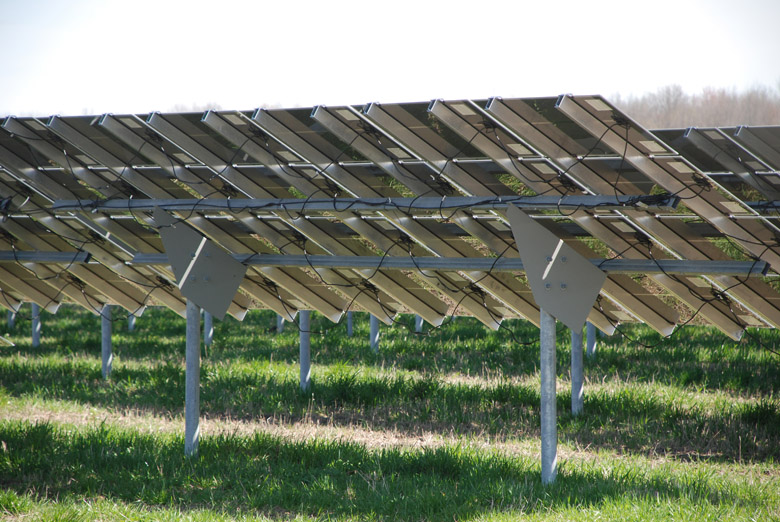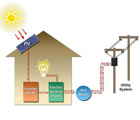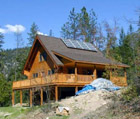

Can I Recommend Ground Mounted Systems?
Most people in the industry accept that ground mounted systems typically produces more electricity than the average roof mounted installation.
Now I would like to examine the topic of choosing between ground and roof mounted systems.
First, two points about how much electricity is generated. If the cost of installing either type of system is nearly the same, and more importantly if the amount of the electricty you generate is the same for both systems, what other factors should be considered?
- The ground mounted system is delivering more kWh to the grid, and so is providing a greater benefit towards the goal of eliminating coal fired peaking generation plants and is greener.
- “net metering” where you use your own power and use the grid as a logical storage element to “store” electricity that is surplus to you daytime needs, and consume power from the grid at nightime or on cloudy days. You only are charged for any amount of electricity that you consume that is in excess of that which you generate, averaged over a ling period of time. Any extra that you generate in excess of your consumption, on a long term average is not paid to you, the surplus is provided free to the grid. Net Metering hopefully drives your electricity bill to zero. The important point with net metering is that you are displacing electricity that you otherwise buy at the retail price with that generated from your own panels, and if your system generation matches your consumption you are receiving the retail price for all of your solar generated electricity. Today that is about 15 cents, in 20 years it probably will be more.
Now for some other considerations in choosing between roof and ground mounted systems.
Ground Mounted Advantages:
- Safety – Ground mounted systems are safer to build and maintain
- There is much lower risk to the installation crew due to falling when a ground mounted system is installed.
- On a roof mounted system, the homeowner is at a risk when they try to clear snow from their panels
- During the summer. bird soiling does not requires climbing the roof to clean the panels
- In the winter the home owner may climb the roof to clear snow from the panels, which typically have a lower slope and so are more prone to accumulate snow. A ground mounted system is much easier to keep free of snow.
- Increased risk of lightning strikes due to a grounded metal surface higher than the existing roof. On most residential roofs, they are wood frame construction, and therefore are an insulator. The solar panels turn your roof into a conductor.
- The higher the panels are mounted, the higher risk due to wind damage.
- Repairs in the winter are much safer, if a roof mounted panel or microinverter fails, you may have to wait for spring to safely service them, if you can’t gain access by renting the use of a cherry picker.
- There is no requirement of AFCI and for "Rapid Shutdown" which add a significant extra cost to a system without producing any more electricity.
- The panel orientation can be due south, for maximum yield.
- The panel slope can be set at the ideal angle for maximum yield.
- There is less of a size constraint than on a roof, so an installation is more likely to support a 10kW system.
- With less area constrains the lower cost per watt polycrystalline panels can be used, to reach the 10 kW maximum. Conversely a rooftop system with limited space may have to use more expensive monochrystalline panels to reach 10 kW capacity due to insufficient space.
- With a ground mounted system it often is practical to install slightly more than 10kW STD rated panels, with a 10kW capacity inverter and operate in an inverter limit mode. Note the OME has stated that they require a REA assessessment for all ground mounted installations with more than 12 kW of panels. Please see the MOE website for the full text of the regulation.
- There is no concern about roof leaks due to panel mounting
- The roof shingles can be replaced without removing the solar installation
- Appearance: for some installations a ground mount may be located out of site from the home.
- Warranty concerns, some homeowners are concerned that a roof installation might invalidate the homebuilder’s warranty.
- A ground mounted system may be easier and safer for the do it yourself enthusiast to do some or most of the work themselves, driving down the cost of the system.
- Some type of roofs, such as tile roofs or metal roofs require a more specialized mounting system which will increase the relative costs above that of asphalt shingled roofs.
Roof Mounted Advantages
- If your roof faces nearly due south, and has a 7/12 to 12/12 pitch slope and is big enough to hold all the panels you wish to mount, and there are no obstacles such as pipes chimneys or dormers causing shade, then the cost of installation is lower.
- A higher location may be less subject to shading, and its attendant reduction in productivity, particularly in a non-rural environment.
- A roof installation is a little less expensive than a ground mounted system
- A roof mounted system can be installed in less time, particularly on a bungalow.
As part of a site assessment I use a tool called a Solar Pathfinder to analyze the impact of roof orientation and shading to determine the solar harvest at a particular location. If both a roof and ground mount are being considered, this can be done for both locations to determine the revenue generated from each type of mounting.
An alternative type of ground mounted system uses a tracking mount, which costs more (About $25,000 more on average according to the OPA in 2010) and get about a 30 to 40% increase in the amount of electricity generated with a dual axis tracker. Note that in order to achieve the upper end of these gains with a tracker, there must be a clear view of the sky right to the horizon for about 248 degrees of arc so the panels can be unshaded from sunrise to sunset. This precludes nearly all urban locations. Note that with a tracker there are more things to go wrong, the system no longer has the simplicity of no moving parts.
Net Metering Financial View
A ground mounted system will produce more power, if the roof does not have the ideal orientation. Over the lifetime of the system, typically 25 years, a little greater installation cost to achieve more power due to optimal orientation will pay for itself. Also if you wish to maximize your energy captured, clearing the snow in the winter is much simpler on a ground mounted installation.
Conclusion
If there is no possibility of mounting panels on an unshaded south facing roof with a 20 to 45 degree slope, and at least enough suitable area, then a fixed ground mounted system will generate more electricity. For net metering, a ground mount makes a lot of sense.
There is a lot of piece of mind when a solar system is installed with a ground mount, since the roof is not disturbed. For a roof mounted system, unless the roof has been recently re-shingled a new shingling job should be done before the solar installation, and that should be factored into the cost.





